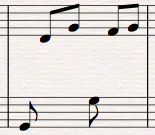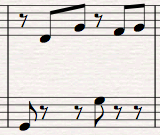Search the Community
Showing results for tags 'rests'.
-
In regards to what is more comfortable to read, I have been struggling between 2 ways of notating the same 6/8 rhythm. using ties not using ties Which, out of the 2 bars above, is the preferred way to notate such rhythms for the sake of simplicity and quick understanding by the musician being asked to read? --------------------------------------------------------------------------- Also, when writing out a part for a harpist, I read that it is customary to forego writing out the rests unless an intended rest is actually to be played (i.e. the harp is a naturally legato instrument). Out of the two bars below, and with respect to how a harpist would like to see the notation, is either one better than the other? The music outlined by the written bars here is, in fact, legato (no rests), however, I didn't want to break the reading musician's ability to count into a measure using any visible rests (especially for more complicated bars of music than pictured here). rests no rests
-
Are there any conventional style rules for how to divide up a rest for best read-ability? For instance, if I'm in 6/8 time, and a part has a 1/16 pickup note to a measure, how would you choose to write the rest before the 1/16 note? A dotted quarter rest, followed by a quarter rest, followed by a sixteenth rest? (To help them see the relation between their rhythm and the greater pulse of the piece at a glance). Or a half rest followed by a dotted eighth? (Because it just keeps the page cleaner.) A dotted quarter rest, followed by an eighth, followed by a dotted eighth? Does anyone else think about these things, or is it just me? Generally, the trickier the rhythm, the more likely I am to write it in a way that nicely subdivides the beats so that you can't help but count it correctly. Since we all tend to fall asleep and stop counting on the rests. Particularly long rests. And I tend to put it in relation to another rhythm in another part on the page. So if while you are resting, someone else's part goes quarter note, dotted eighth, I'll write your rest as quarter note, dotted eighth so the relationship is clear, and you know you can just listen to them, and then come in. But if their part goes dotted eighth, quarter, I'll write yours as dotted eighth, quarter. But if it's a situation where the conductor will have a hand free to give you a big fat cue, maybe it's tidier to just write rests in as long of values as possible as opposed to subdividing. Are there actually conventions for this? There are for everything else… But I've never seen this addressed in a style guide.




